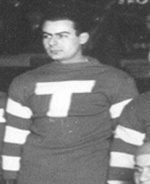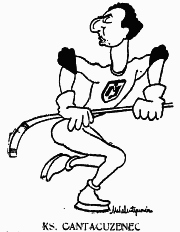Constantin Cantacuzino
| Constantin Cantacuzino | |

| |
| Position | Center |
| Teams | Tenis Club Roman Bucharest HC Bragadiru Bucharest Venus Bucharest |
| National team | |
| Born | November 11, 1905, Bucharest, Romania |
| Died | May 26, 1958, |
| Playing Career | 1928 – 1942 |
Constantin "Bâzu" Cantacuzino (November 11, 1905 in Bucharest, Romania - May 26, 1958) was a Romanian hockey player who was among the best in the country prior to World War II.
Hockey career
Cantacuzino began his hockey career with HC Rosey Gstaad in Switzerland in 1922. He had previously been introduced to the game in the Austrian capital of Vienna. He later joined Tenis Club Roman Bucharest and played for them for the rest of the 1920s into the 1930s, save for a brief stint with the Austrian club, HC Währing, winning multiple Romanian Championships.
He captained the Romanian National Team and made five appearances with them at the World Championships between 1931 and 1937. Cantacuzino also played for Romania at the last European Championship in 1932.
A man noted for his sportsmanship, Cantacuzino asked the referee to write a message addressed to the American National Team after losing to them 15-0 at the 1931 World Championship. It read, "Thank you for playing against us, we have learned a great deal from this game."
Cantacuzino joined the newly-founded HC Bragadiru Bucharest in 1935 and promptly won the 1936 Romanian Championship with them. He later went on to play for Venus Bucharest from 1939-1942.
Aviation career
In 1939 he won the national aerial aerobatics contest with his Bü 133 Jungmeister and in 1941 was named chief pilot of the Romanian national air transport company LARES. Even though this was a comfortable job, he managed to get in the front line as a fighter pilot in the 53rd Fighter Squadron (equipped with Hurricane Mk. I).
After the capture of Odessa, the Romanian Army reduced the number of front line troops and he was one of the reservists who were sent home. He took up his position at LARES. However he managed to arrange a return to active duty in 1943. On 26 April 1943 he was remobilized and assigned to the 7th Fighter Group, which was equipped with the new Messerschmitt Bf-109. On 5 May he arrived on the front line and was named commander of the 58th Fighter Squadron. On 29 June, he and his wingman engaged four Yakolevs, two La-5s and four Spitfires, while trying to protect three Romanian Ju-88s bombers. His wingman was badly hit and forced to return to base. He continued the fight on his own and shot down two Spitfires. His aircraft was damaged, but managed to escape and make a belly landing. Two of the bombers were destroyed. In July he flew both day and night missions, even though his aircraft was not equipped for low-visibility flying. Cantacuzino tried to stop the Soviet night bombings of his airfield. The Germans protested, considered him a little mad, so he eventually gave up the night missions.
On 27 July 1943, he shot down the Soviet Air Forces' flying ace Nikolay F. Khimushin (12 kills). Between 2 and 5 August he shot down none aircraft (four Yaks and five Ilyushin Il-2 ground attack aircraft), raising his score to 27. On 5 August he was alone on patrol and he encountered a Soviet formation about 40-50 planes strong (Il-2s and Yaks). He realized that he could not destroy them all, but felt he could inflict some damage on the formation. He dove into the Il-2 formation and shot down two of them before he was attacked by the Soviet fighters. He managed to shake them off and shoot down one. The day of 16 August was an excellent day for the pilots of the 7th Fighter Group. They scored 22 confirmed kills and five probables, with Cantacuzino shooting down three (two La-5s and a Il-2). On 28 August he received the Iron Cross, 1st class.
In the autumn of 1943 Cantacuzino became ill and was interned in a hospital and was kept from the front so he could rest and recuperate. On 10 February 1944 he returned to active duty in the 7th Fighter Group, which was sent to the front with the Soviets in Moldova. On 15 April, there was a USAAF raid and Cantacuzino and his wingmen attacked the bomber formations and shot down six B-24 Liberators (the prince got one himself). He continued flying missions against the Soviet Air Force and scored several victories.
In August 1944, Cantacuzino became the commander of the 9th Fighter Group, succeeding Captain Alexandru Şerbănescu, who was shot down in combat with US fighters on August 18.
After 23 August 1944, when Romania quit the Axis, the Luftwaffe started bombing Bucharest from airfields close to the capital which were still in German hands. The remains of the 7th and 9th Fighter Groups were brought in to protect the capital. Cantacuzino shot down 3 Heinkel He-111s on this occasion.
Cantacuzino was then given a special mission: to transport Lieutenant-Colonel James Gunn III, the highest ranking American prisoner-of-war in Romania, to the airbase at Foggia and return to Romania with 56 B-17s converted for transport duty to airlift 1,274 U.S. PoWs. He returned flying a P-51 Mustang because his Bf-109 could not be refueled. He needed only one flight to become familiar with the new aircraft and dazzled the Americans with his aerobatics.
Cantacuzino was credited with 43 aerial victories (one shared) and 11 unconfirmed. According to the counting system used through much of the war, his kill total was 69, the highest in the Romanian Air Force.
After the war ended, Cantacuzino was demobilized and returned to LARES. The USSR imposed a communist regime that confiscated private property and began imprisoning the old elite and opponents of the regime. Cantacuzino lost all his land and soon his wife left him. In 1946 he married Nadia Gray. He managed to escape to Italy in 1947 and then he settled in Spain. There he was helped by the Romanian community to buy himself an airplane, in order to earn his living at air shows.
Personal life
Cantacuzino was born in Bucharest. His father was Mihai Cantacuzino and his mother Maria Rosetti; they were both from old Romanian noble families. After his father died, Maria Rosetti married for a second time, to George Enescu (Romania's greatest composer and a world class violinist).
The Cantacuzino's were a Romanian aristocratic family that gave several Princes of Wallachia and Moldavia, descending from a branch of the Byzantine Kantakouzenos family, specifically from the Byzantine Emperor John VI Kantakouzenos (reigned 1347–1354).
He had the official title of "Prince". Cantacuzino was extremely affluent and was known to have a taste for women, numerous sports, as well as cars and especially airplanes.
He passed away after complications during an operation that was performed in Spain on May 26, 1958, at the age of 52.
References
- SIHSS profile
- IIHF (2010). IIHF Media Guide & Record Book 2011. Moydart Press, 528. ISBN 978-0-9867964-0-1.
Credits
Special thanks to Patrick H. for supplying information on this player.
| This page uses Creative Commons Licensed content from Wikipedia (view authors). |
